 USN Dive Bomber – 1935-42
USN Dive Bomber – 1935-42
Rough draft for the Dauntless
Northrop is rarely associated with US Naval aviation, albeit being one of the most famous and innovative aviation company in history. Innovation was its trademark, and its contribution to the Navy during WW2 has been tremendous for a single reason. In 1933, Jack Northrop’s firm was a small subsidiary of Douglas aircraft corp with just a few prototypes and civilian planes to its credit. Its first solid contract for the Navy was indeed in 1935 the BT, a dive bomber characterized by… perforated air brakes. With them, controlled dive and accurate bombing was possible. Despite a small production (only 55), the Northrop BT was the direct inspiration by its mother company -Douglas- to develop the mass-produced SBD Dauntless that turned the tables at Midway and altered the course of the war in the pacific…

About Northrop
Jack Northrop’s first company was called Avion Corporation in 1928. It was absorbed in 1929 by the United Aircraft and Transport Corporation, as a subsidiary and renamed “Northrop Aircraft Corporation”. It moved first to to Kansas in 1931, and later Jack and Donald Douglas created “Northrop Corporation” in El Segundo, California. With a blessed weather, the company soon launched a serie of innovative single-engine passenger planes, the Alpha, Beta and Gamma. Labor difficulties led to its dissolution by Douglas in 1937 and it became as simple division Douglas Aircraft.
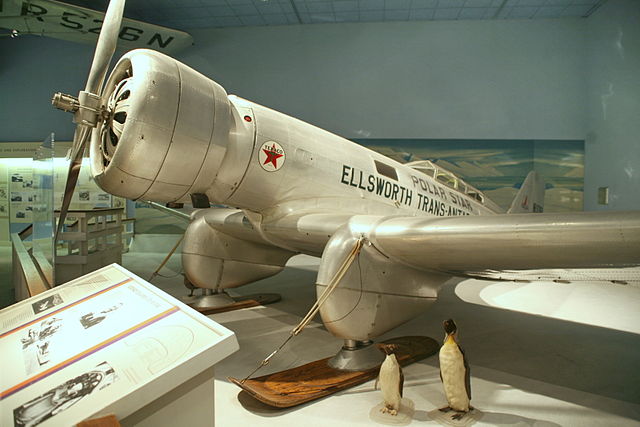
Northrop 2B Gamma Polar Star
In between, Northrop started to compete in Army Air Force and Navy programs. Its first attempt was the Northrop YA-13, a prototype of attack aircraft derived from the Gamma, evaluated but rejected by the USAAF. Improved, it became the Northrop A-17, which this time met success from 1934 (first flight), with 411 produced, in large part for export. Douglas liked the design, which became its A-33. Later in 1940, it led to a short production of its only floatplane, the Northrop N-3PB. In parallel, the company competed for the Navy contract which searched for a modern monoplane dive bomber.
Development of the BT
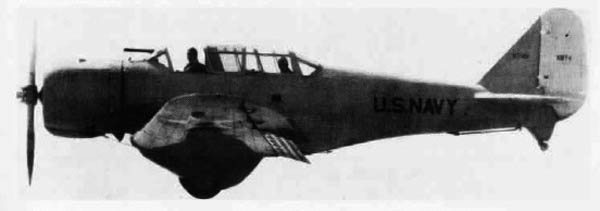
Initial XBT-1 in test flight, 1935
At the end of 1934, the Bureau of Aeronautics (BuAer) of the US Navy, published a specification for a design called “scout bombers”. Its abbreviation was SB, and another torpedo bomber at the same time, monoplanes or biplanes as the Navy was not completely decided yet. Eight companies competed. A total of ten projects were examined divided equally between monoplanes and biplanes. Northrop answered with its XSB prototype, powered by a 14-cylinder Pratt & Whitney XR-1535-66 700 hp (520 kW). It was a double star engine. The prototype also had retractable landing gear, rearward in large prominent fairings under the wings. But as the model was supposed to dive bombing, Northrop engineers came up with an ace of their sleeves: Tad two-piece perforated flaps (opening up and down) better known as “nose-down brakes”. These perforated flaps were invented to eliminate unstable oscillations (“buffeting”) of tail during these nose-down maneuvers. This really was a breakthrough as its ensured the best accuracy possible. The plane did not became erratic at the most critical moment. The Navy was much impressed, but found the bird underpowered.
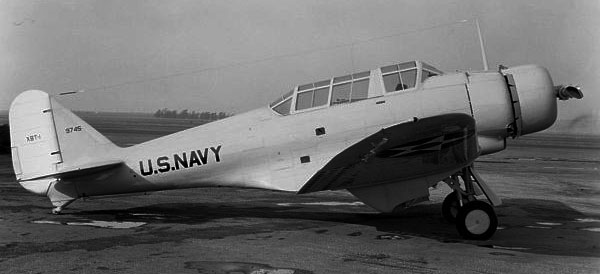
Northrop XBT-1, December 1936
Northrop therefore developed their next version called the XBT-1. It was fitted with a 750 hp (560 kW) R-1535 Pratt & Whitney double star engine. Again, it was tested and proved superior in many areas so the Navy was content with a few production and service modifications proper to navy use. Thanks to the new engine, the XBT had a reserve of power allowing some extra load. However in 1935-36, both a protective armor for the pilot’s neck or self-obturating tanks were not asked for.
In 1936 the XBT-1 was inspected a last time with the modification asked by the Navy and received the greenlight for production once procured the new Pratt & Whitney engine R-1535-94. It was capable of delivering 825 hp (615 kW). The other last requirement was a new tail wheel.
Meantime, Northrop tested a BT-1 modified with a fixed tricycle landing gear. It was tested by the navy and made the first tricycle landing on an aircraft carrier ever. however it was not accepted. By September 1936 at last, the pre-production BT-1 was inspected and followed by an order for 54 BT-1s. Despite its innovations and better engine, the BT-1 proved however disappointing in operations. The Navy nevertheless had supporters for Northrop’s design and ordered modifications which ended with XBT-25.
From the BT-1 to the Dauntless
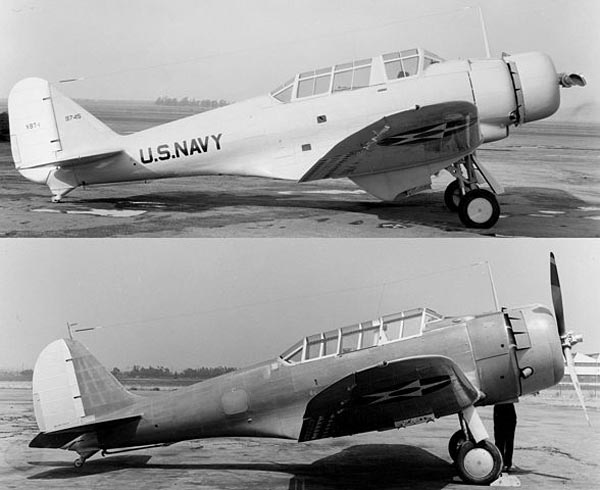
Comparison between the XBT-1 and XBT-2
The XBT-25 was a modified BT-14 in 1937, and the 54th modified production BT-1. It incorporated a new landing gear, which retracted laterally inside wings recesses, a far more conventional solution. The elimination of the massive fairings supposed to improved a lot the aircraft’s flight characteristics, speed and handling. But Northrop went further and gave it fixed-slot leading edge slats, a redesigned canopy (with straight framing, no longer oblique) and above all the 800 hp (600 kW) Wright XR-1820-32 star engine. It was renamed XBT-2, and the prototype first flew on April 25, 1938. Still, it had bad flight characteristics, beyond what was expected. Alas, the Navy ordered the XBT-2 to be tested at NACA’s Langley Research Center in Virginia. A series of wind tunnel tests were performed, at the conclusion of which, it was sent back to Northrop with a set of recommendation, leading to a complete overhaul of the design.
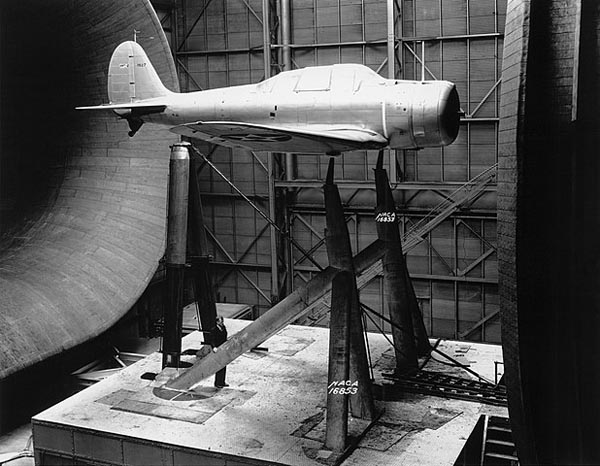
NACA’s tests of the XBT-2
In late 1938, the modified XBT-2 went through a new serie of company tests, and Navy tests, which were successful. The Navy placed a new order, this time for 144 BT-2s, now far away from the BT-15. In 1939 since Northrop was integrated into Douglas, the BT-2 became under the new navy nomenclature “Douglas SBD-1”, while a host of modifications during production generated for the next batch of 87 aircraft, the SBD-2. Jack Northrop left his company and created a new one under his name, “Northrop Aircraft”, while the facility responsible of the SBD was now simply called the El Segundo division of Douglas, in California. The name “Dauntless” was not official. Like many other names it was chosen after a vote in the Navy during the war as a better way to identify these, rather than more obscure acronym.
Design
The BT-1 looked modern in 1935, with its cantilever wing (not foldable), nice lines and dynamic windshield cockpit design. The very large, prominent wheeltrain fairings looked odd however, and that solution was never repeated. It had a crew of two, the pilot and gunner at the rear. The fuseage measured 31 ft 8 in (9.65 m) for a wingspan of 41 ft 6 in (12.65 m), a total height on the tarmac of 9 ft 11 in (3.02 m) and a total wing area of 319 sq ft (29.6 m2).
Its Empty weight was 4,606 lb (2,094 kg), and Maximal takeoff weight 7,197 lb (3,271 kg).
The BT-1 (production version), relied on the Pratt & Whitney R-1535-94 Twin Wasp Junior, double row (radial) and air-cooled. It developed 825 hp (615 kW), which at the time was respectable, but by 1942 standard, it was underpowered. Its Performances reflected this, with a top speed of 193 knots (as referred in the Navy) or 222 mph, 357 km/h, at 9,500 ft (2,900 m). Its cruise speed was 167 knots (192 mph, 309 km/h). Its range was rounded at 1,000 nmi (1,150 mi, 1,852 km) at this cruise speed of 300 kph. Its service ceiling was 25,300 ft (7,710 m), but reached with an anemic rate of climb of 1,270 ft/min (6.5 m/s).
Its armament comprised a single .50 in (12.7 mm) Browning M2HB heavy machine gun mounted in the nose, left side, and a single .30 in (7.62 mm) browning M1919A4 machine gun mounted on a railing aft of the cockpit for the gunner. It was folded down during flight and retracted to point the gun outwards as the aft glass tail was folded up and backwards.
As a dive bomber, the BT-1 carried a 1,000 lb (454 kg) bomb under the fuselage’s belly, mated on a launching fork, allowing it to clear the propeller. The BT-1 was seen also with standard underwing rack, probably for two 116 lb (52.6 kg) Mk IV bombs (one under each wing).
Variants
BT1S: After the XBT-1 and the 54 production BT-1s, the company tested the BT-1S. It was BuNo 0643 fitted with a fixed tricycle undercarriage. Unfortunately the prototype was badly damaged in a crash, on 6 February 1939, putting an end to the experimentation. It was returned to Douglas, repaired and converted to a standard BT-1.
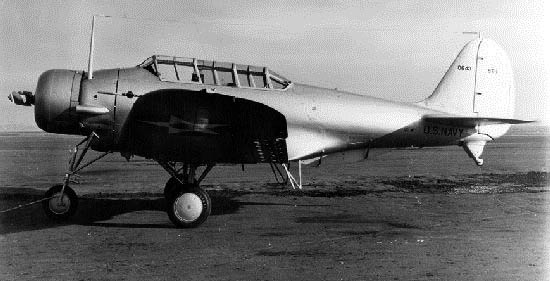
BT-1S showing its tricycle undercarriage
XBT-2: This was a BT-1 receiving a fully retractable landing gear to reduced drag, followed by many other modifications. The landing gear folded laterally into recessed wheel wells. In addition, it had leading edge slots and a redesigned canopy. The biggest change was its better engine, the 800 hp (600 kW; 810 PS) Wright XR-1820-32 radial. This XBT-2 first flew on 25 April 1938. Testings were so successful that the Navy placed an order for 144 aircraft. But by that time, in 1937, Douglas had taken over northrop, which became its local division in California, not because Douglas had a greater manufacturing capacity. These were produced at Northrop, which plant underwent a radical upsizing. In 1939 indeed, its designation was changed to SBD-1, while the second half of the batch, 87 planes, were modified and completed as the SBD-2. But until the, what became the famous Dauntless was known as the Northrop BT-2.
The Japanese BT1: Last derivative, the Douglas DB-19 was former BuNo 0643 BT-1S that we saw above, which was modified as the DB-19. It was tested by… the Imperial Japanese Navy under the name of DXD1 (a designation meaning “Douglas Navy Experimental Type D Attack Aircraft”). No doubt it was fruitful for Japanese engineers at the time.
Operational History
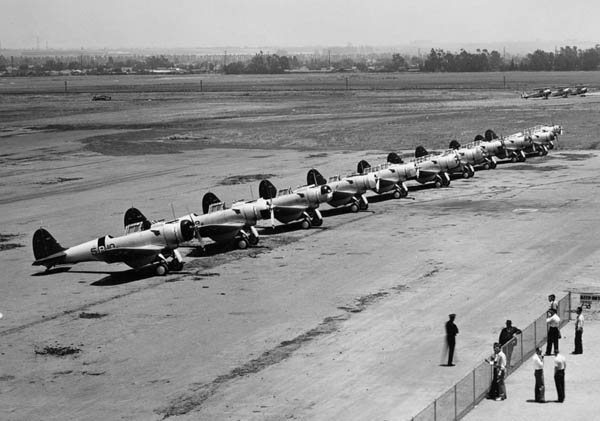
Northrop BT-1s of VB-5 lined up in 1939
The U.S. Navy 54 BT-1s entered service during 1938. They served on USS Yorktown and Enterprise. They were not popular, having poor handling characteristics notably at low speeds, making them unsuitable to land on an aircraft carrier. In flight also, it was also prone to unexpected rolls and a number of these crashed during regular flights, when pilots tried their luck in hazardous manoeuvers. The Vindicator was preferred, and from late 1940 it was phased out to the new SBD-1 and SBD-2, lightyears above in any directions. Despite being retired from frontline units, the Northrop BT-1s went to serve with the USMC and the remainder in various coastal Naval Air Bases. Among the last in service were planes from NAS Pensacola in 1942. The same year they were declared “limited standard” and retired due to the lack of spare parts until 1943. BT-1s nevertheless took part in their prewar livery in the Technicolor “Dive Bomber” (1941) starring Errol Flynn, together with Vindicators, Helldivers (biplanes) and Devastators.
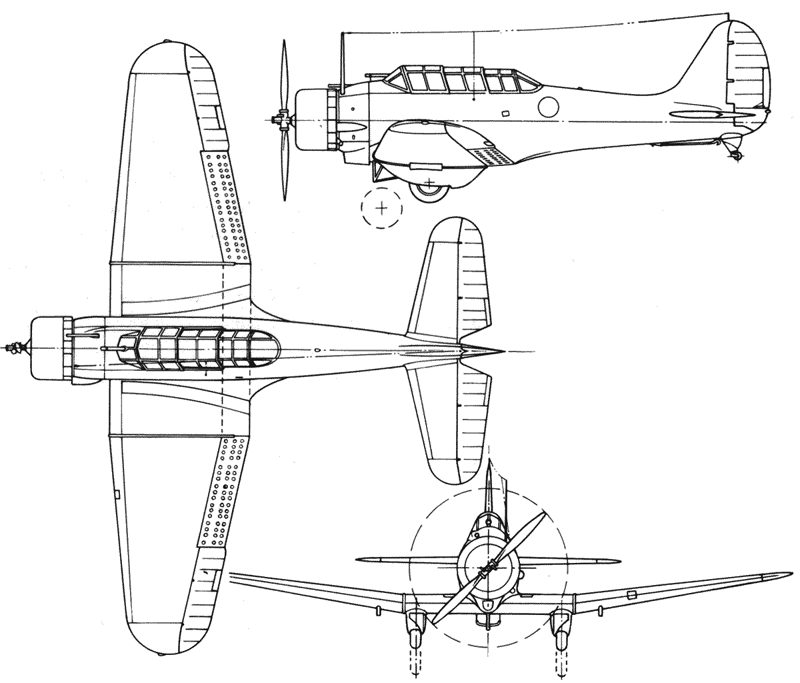
Specifications BT-1 |
|
| Dimensions*: | 9.65 x 12.65 x 3.02m (32 x 41 x 9 ft) |
| Weight (Light): | 2,094 kgs (4,606 lb) |
| Weight (Max take-off): | 3,271 kg (7,197 lb) |
| Propulsion: | Pratt & Whitney R-1535-94 Twin Wasp Jr |
| Performances: | 825 hp (615 kW), 357 km/h (222 mph) |
| Range: | 1,000 nmi (1,150 mi, 1,852 km) |
| Armament – MGs: | 1x 0.5 in, 1x 0.3 in |
| Armament – Bombs: | 1,000 lb (454 kg) under fuselage, 2x 116 lb (52.6 kgs) under wings |
*Length, Wingspan, Height
Read More/Src
//www.warbirdsresourcegroup.org/NARG/northropbt.html
//www.histomin.com/Aviation/Classic%20Aircraft%20Between%20the%20Wars/Northrop%20BT-1/gpclassics%20Northrop%20BT-1%20Bomber.htm
//www.aviastar.org/air/usa/northrop_bt.php
//www.flickr.com/photos/dougsheley/3627439969
//www.historyofwar.org/articles/weapons_BT-1.html
//www.youtube.com/watch?v=1WEfg9q-TYY
//en.wikipedia.org/wiki/Northrop_BT
//en.wikipedia.org/wiki/Northrop_Corporation
//www.airvectors.net/avsbd.html
Model kits: //www.scalemates.com/search.php?fkSECTION%5B%5D=All&q=northrop+BT*
Northrop BT-1, Phil H. Listemann 2008, Philedition
Bowers, Peter M. United States Navy Aircraft since 1911. Annapolis, MD: Naval Institute Press, 1990
Brazelton, David. The Douglas SBD Dauntless, Aircraft in Profile 196. Leatherhead, Surrey Profile Publications Ltd., 1967
Drendel, Lou. U.S. Navy Carrier Bombers of World War II. Carrollton, TX: Squadron/Signal Publications, Inc., 1987
Gunston, Bill. The Illustrated History of McDonnell Douglas Aircraft: From Cloudster to Boeing. London: Osprey Publishing, 1999.
Kinzey, Bert. SBD Dauntless in Detail & Scale, D&S Vol.48. Carrollton, TX: Squadron/Signal Publications, Inc., 1996.
Listemann, Phil. Northrop BT-1 (Allied Wings No.3). France: www.raf-in-combat.com, 2008.
Swanborough, Gordon and Peter M. Bowers. United States Navy Aircraft since 1911. London: Putnam, Second edition, 1976.
Illustrations:
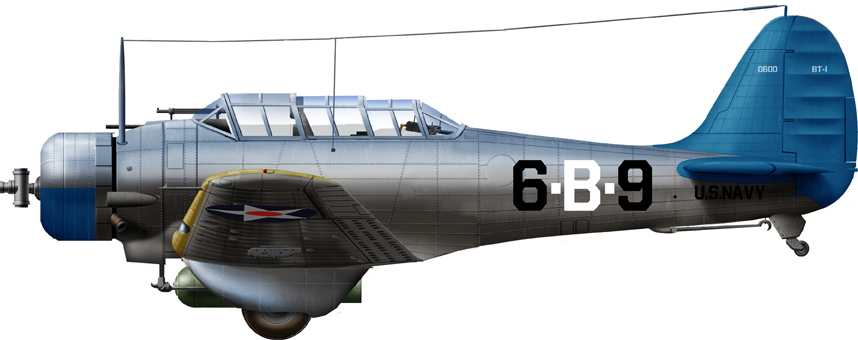
BT-1 if VB-6 (USS Enterprise), 1938
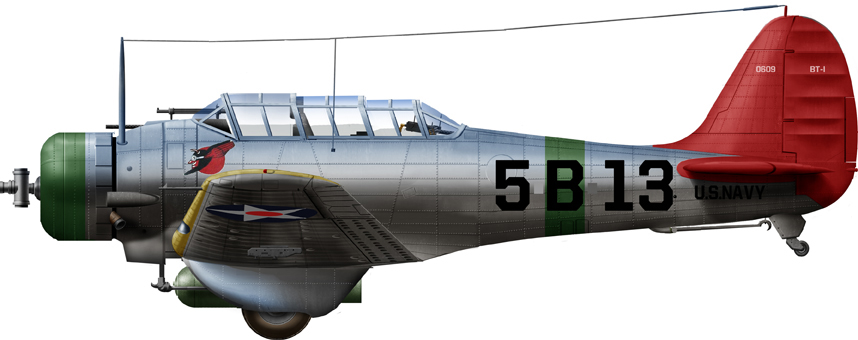
BT-1 of VB-5 (USS Yorktown), 1938
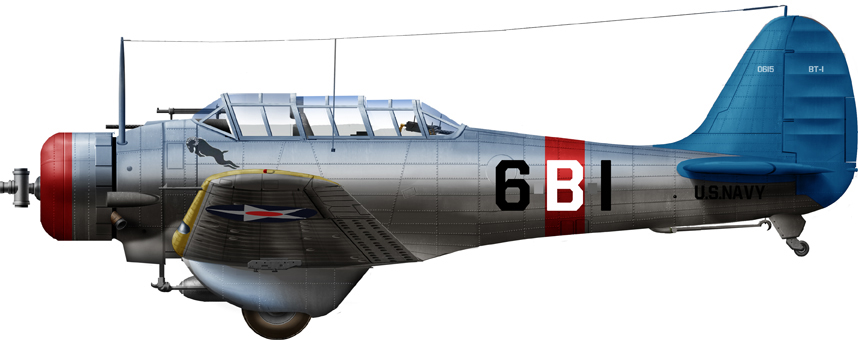
BT-1 VB-6, CV6 (USS Enterprise) 1939
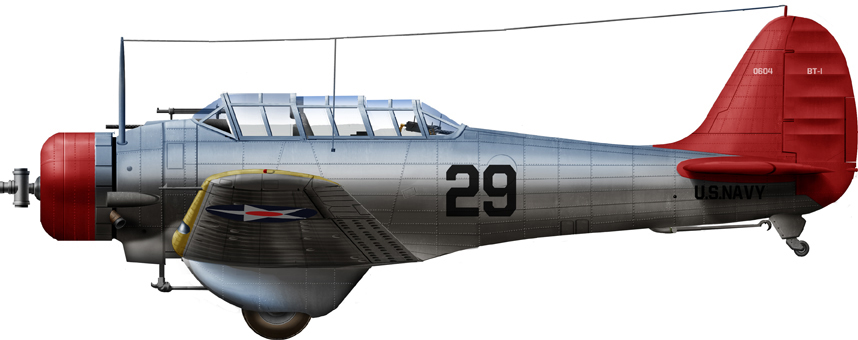
BT-1, NAS Miami, in 1941
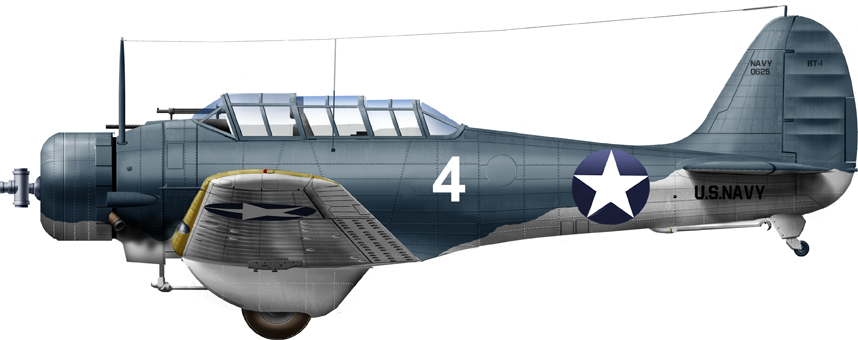
BT-1 from VN-5, NAS Pensacola, 1942
Photos:
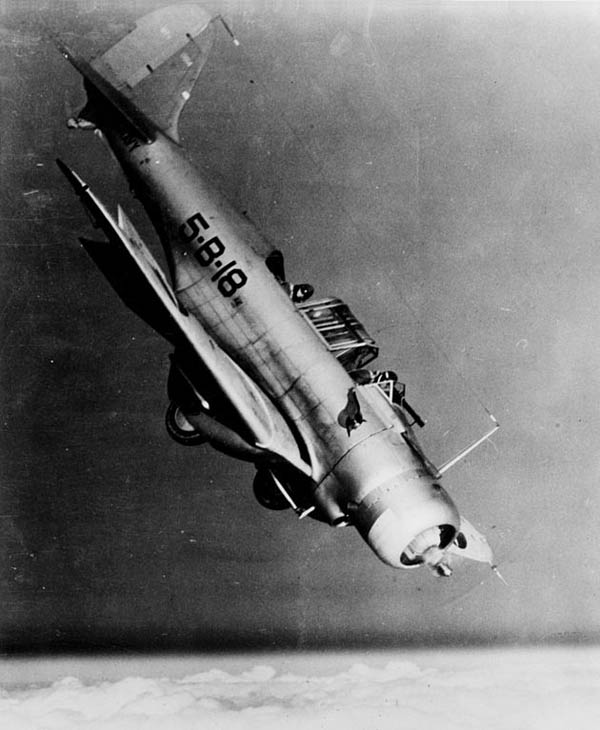
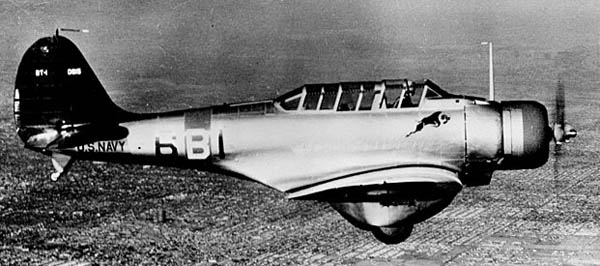
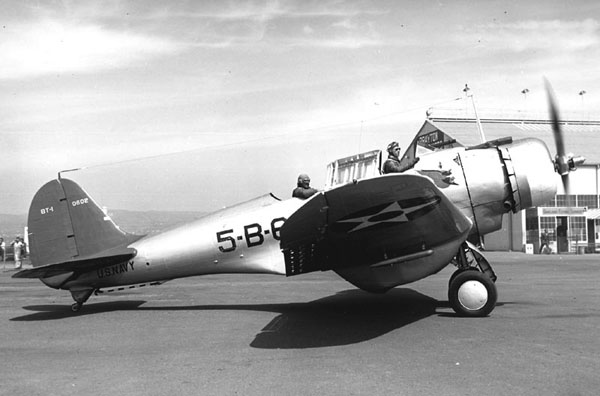
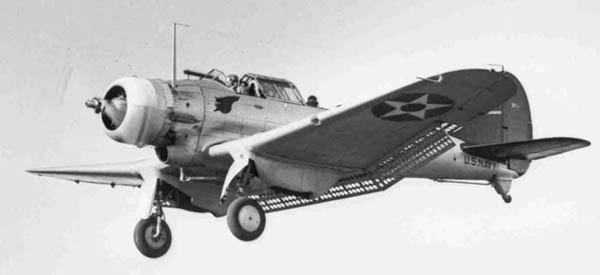
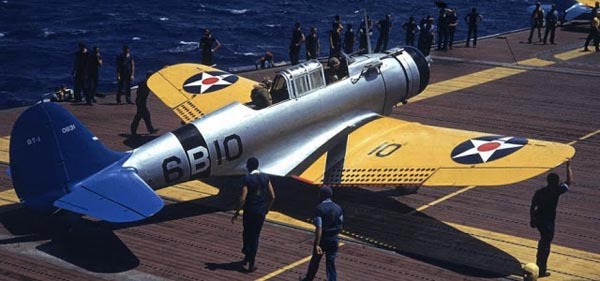
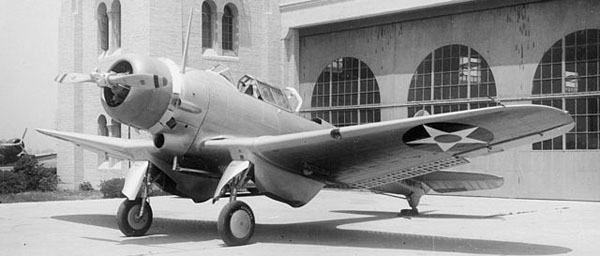
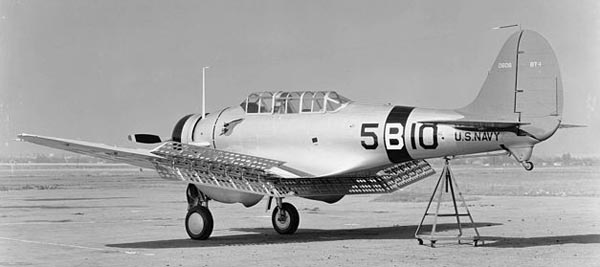
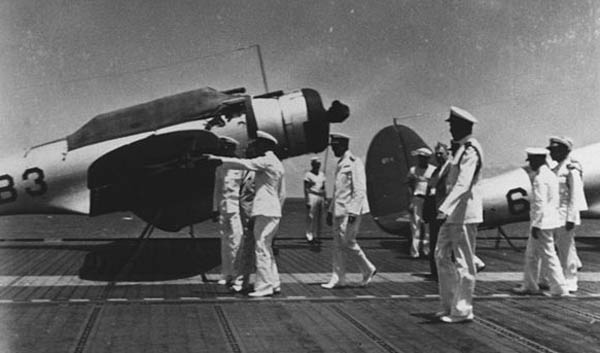

 Latest Facebook Entry -
Latest Facebook Entry -  X(Tweeter) Naval Encyclopedia's deck archive
X(Tweeter) Naval Encyclopedia's deck archive Instagram (@navalencyc)
Instagram (@navalencyc)





 French Navy
French Navy Royal Navy
Royal Navy Russian Navy
Russian Navy Armada Espanola
Armada Espanola Austrian Navy
Austrian Navy K.u.K. Kriegsmarine
K.u.K. Kriegsmarine Dansk Marine
Dansk Marine Nautiko Hellenon
Nautiko Hellenon Koninklije Marine 1870
Koninklije Marine 1870 Marinha do Brasil
Marinha do Brasil Osmanlı Donanması
Osmanlı Donanması Marina Do Peru
Marina Do Peru Marinha do Portugal
Marinha do Portugal Regia Marina 1870
Regia Marina 1870 Nihhon Kaigun 1870
Nihhon Kaigun 1870 Preußische Marine 1870
Preußische Marine 1870 Russkiy Flot 1870
Russkiy Flot 1870 Svenska marinen
Svenska marinen Søværnet
Søværnet Union Navy
Union Navy Confederate Navy
Confederate Navy Armada de Argentina
Armada de Argentina Imperial Chinese Navy
Imperial Chinese Navy Marinha do Portugal
Marinha do Portugal Mexico
Mexico Kaiserliche Marine
Kaiserliche Marine 1898 US Navy
1898 US Navy Sovietskiy Flot
Sovietskiy Flot Royal Canadian Navy
Royal Canadian Navy Royal Australian Navy
Royal Australian Navy RNZN Fleet
RNZN Fleet Chinese Navy 1937
Chinese Navy 1937 Kriegsmarine
Kriegsmarine Chilean Navy
Chilean Navy Danish Navy
Danish Navy Finnish Navy
Finnish Navy Hellenic Navy
Hellenic Navy Polish Navy
Polish Navy Romanian Navy
Romanian Navy Turkish Navy
Turkish Navy Royal Yugoslav Navy
Royal Yugoslav Navy Royal Thai Navy
Royal Thai Navy Minor Navies
Minor Navies Albania
Albania Austria
Austria Belgium
Belgium Columbia
Columbia Costa Rica
Costa Rica Cuba
Cuba Czechoslovakia
Czechoslovakia Dominican Republic
Dominican Republic Haiti
Haiti Hungary
Hungary Honduras
Honduras Estonia
Estonia Iceland
Iceland Eire
Eire Equador
Equador Iran
Iran Iraq
Iraq Latvia
Latvia Liberia
Liberia Lithuania
Lithuania Mandchukuo
Mandchukuo Morocco
Morocco Nicaragua
Nicaragua Persia
Persia San Salvador
San Salvador Sarawak
Sarawak Uruguay
Uruguay Venezuela
Venezuela Zanzibar
Zanzibar Warsaw Pact Navies
Warsaw Pact Navies Bulgaria
Bulgaria Hungary
Hungary

 Bundesmarine
Bundesmarine Dutch Navy
Dutch Navy Hellenic Navy
Hellenic Navy Marina Militare
Marina Militare Yugoslav Navy
Yugoslav Navy Chinese Navy
Chinese Navy Indian Navy
Indian Navy Indonesian Navy
Indonesian Navy JMSDF
JMSDF North Korean Navy
North Korean Navy Pakistani Navy
Pakistani Navy Philippines Navy
Philippines Navy ROKN
ROKN Rep. of Singapore Navy
Rep. of Singapore Navy Taiwanese Navy
Taiwanese Navy IDF Navy
IDF Navy Saudi Navy
Saudi Navy Royal New Zealand Navy
Royal New Zealand Navy Egyptian Navy
Egyptian Navy South African Navy
South African Navy






























 Ukrainian Navy
Ukrainian Navy dbodesign
dbodesign